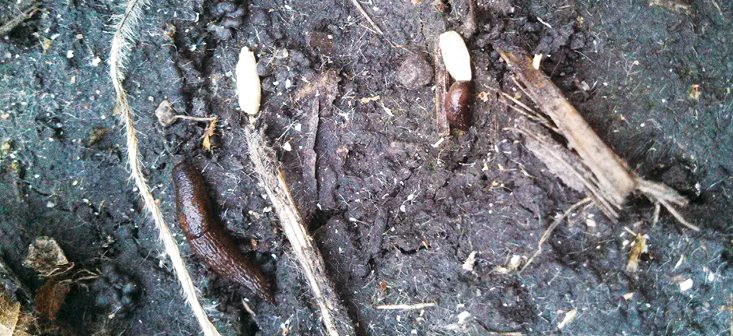Pictured Above: EXPENSIVE MEAL. Slugs feast on the germ end of cereal rye seed that was aerially applied into a field of standing soybeans last fall near Waupun, Wis.
Aerial seeding is a popular method to help no-tillers get cover crops established in a timely manner, especially in far northern U.S. climates where growing seasons are shorter and application windows are tight.
In fact, 23% of row-crop farmers say aerial seeding is their primary means of applying covers, only behind drilling at 38%, according to Sustainable Agriculture Research and Education’s (SARE) most recent cover crop survey.
If results from aerial seeding are spotty, some farmers are quick to point the finger at the pilot. While pilot error is possible, there’s a whole lot more that goes into successful applications, says Damon Reabe.
In the Dark?
The president at Waupun, Wis.-based Reabe Spraying Service says continued work with cover crops has convinced him that many no-tillers in cold climates are having covers flown on too early in the fall, leaving them subject to reduced sunlight.
For instance, during an early fall where corn harvest might be ongoing in early October, there’s enough time for covers seeded in September to access enough heat units and daylight to grow up through post-harvest residue.
But if harvest happens in November, when there’s fewer heat units and daylight, leftover residue might smother the covers and kill them before farmers see any results. Reabe says in Wisconsin he will often refuse to seed covers into grain corn if growers are harvesting after Oct. 10.
Waiting longer for aerial seeding is important because cover crops are more likely to get sunlight, which they need even more than water, says Reabe, whose company seeds about 20,000 acres of covers annually.
“If we put seeds out early into a living corn crop, prior to any significant senescing, the seeds will germinate and put down a root maybe half an inch into the ground, and the plant will use all its energy to compete for sunlight with the existing crop,” he says. “You will have really long grass with a shallow root, and the only way it will survive is if the soil surface is moist all the time. I’ve watched plants die from drought stress because the root is only in the ground half an inch.”
The same holds true for soybeans, Reabe says. While some no-tillers will try to time cover applications during yellowing, before leaf drop to maximize seed-to-soil contact, applying seed in the canopy’s shade can reduce the sunlight that exists for growth.
Many cover crop seeds suitable for broadcast will germinate successfully even after leaf drop with a little wind and rain, he says.
Time to Eat
Flying on cover crops too early can also lead to an increased risk of seed predation, which Reabe has seen happen personally.
Last September in Wisconsin, armies of slugs in soybean fields ate the germ on cereal rye seed in many fields, killing any chance of germination. Seed can also be prey for birds, moles and other animals, as well as soil-surface pathogens.
“What I don’t want to do is put covers into a lush canopy where pathogens are doing well and slugs are doing awesome,” Reabe says. “I want to put the seed on a deserted surface. If you put covers out near harvest, there’s enough residue for the slugs to sort through that they might have a more difficult time getting to the seed.”
Reabe says he’s also seen earthworms gather up cover-crop seed and bring it into their burrow.
“You do the seeding and walk out there and you see a scattered pattern, like normal, and then come back 2 weeks later and all of the seed is germinated in clumps,” he says. “That didn’t happen by itself.”
Best Bets
Discounting seeding dates, Reabe says he’s having the best luck in northern states seeding cereal grains like winter wheat, cereal rye, winter oats, annual ryegrass and winter and spring barley.
Brassicas like rape, turnip and radish also tend to do well being broadcast, if they have about 6 weeks to germinate and grow.
In his area, Reabe tries to avoid small-seeded legumes and brassicas like clover and hairy vetch in aerial applications due to both cost and the unlikelihood the covers will grow enough to provide a benefit. He also tends to avoid large-seeded legumes like peas.
“Many drills have a chart you can see when you open the hopper lid that has suggested planting depths. If the suggested depth is ¼-¾ of an inch, it can be broadcast. If it’s 1-2 inches, forget it,” Reabe says. “Then it needs to be surrounded by soil and continuously moist.”





Post a comment
Report Abusive Comment